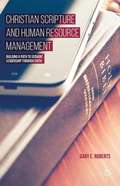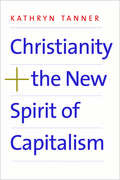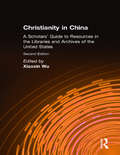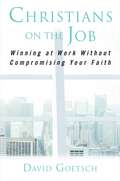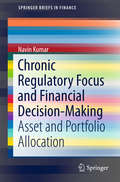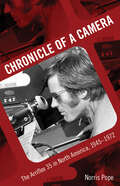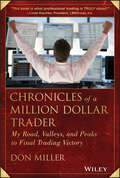- Table View
- List View
Christian Perspectives on the Role of the State, Justice, and Taxation
by Robert F. van BrederodeThis book, Christian Perspectives on the Role of the State, Justice, and Taxation, examines the historical and ongoing influence of Christian ethical thought on taxation, governance, and distributive justice. Building on themes introduced in Political Philosophy and Taxation (Springer, 2022), which focused on secular perspectives, this sequel shifts attention to the contributions of Christian thinkers from Medieval times to the present. The book explores key questions surrounding the role of the state, the relationship between the state and its subjects, the moral right to tax, and what constitutes fairness in taxation. It investigates how Christian ethical teachings have shaped Western political philosophy, particularly in the context of distributive justice, and evaluates their relevance in contemporary discussions. By analyzing the intersection of theology, ethics, and political philosophy, this book provides a deeper understanding of how Christian traditions have influenced historical notions of justice, fairness, and governance. It offers insights into how these principles can inform modern policy debates and ethical considerations in taxation. This book serves as a valuable resource for scholars, students, and professionals interested in religious ethics, political philosophy, and public policy. It invites readers to reflect on the enduring impact of Christian thought on concepts of justice and the responsibilities of the state.
Christian Reflections on the Leadership Challenge
by James M. Kouzes Barry Z. Posner John C. MaxwellChristian Reflections on The Leadership Challenge is a faith-based companion to the best-selling leadership book of all time--The Leadership Challenge Grounded in Jim and Barry's time-tested research, Christian Reflections on The Leadership Challenge describes their Five Practices of Exemplary Leadership ® --Model the Way, Inspire a Shared Vision, Challenge the Process, Enable Others to Act, and Encourage the Heart -- and offers practical guidance and inspiring examples about how Christian leaders can have a powerful impact in their workplaces, communities, and congregations by bringing their faith into their leadership. In addition to Jim and Barry?s foundational wisdom, the book brings together five leaders who reflect on the Five Practices from a Christian perspective John C. Maxwell, David McAllister-Wilson, Patrick Lencioni, Nancy Ortberg, and Ken Blanchard share insights and stories culled from personal experience and the lives of other Christian leaders who have accomplished extraordinary things in churches, communities, classrooms, and corporations Their thoughtful reflections on the role of faith in leadership will propel leaders and aspiring leaders
Christian Scripture And Human Resource Management
by Gary E. RobertsChristian Scripture and Human Resource Management provides a much-needed Christian faith-based perspective on human resources management written for both line and human resource managers using the framework of servant leadership, the mandated leadership approach used by Jesus.
Christian Theology of Public Policy: Highlighting the American Experience
by John M. CobinShould you read this book? Perhaps you are a Christian who believes or suspects that today's public policies are wrong, or at least harmful to Christians. You would like to understand better what the Bible, informed by logic, history, economics, and political science, teaches about citizenship and what kind of society is best for Christians. If so, you will find this book interesting and useful.
Christian-Owned Companies: What does it look like when a follower of Jesus runs a business?
by Michael ZigarelliOne Question, Fifty Companies, Eight Practical Answers. What does it look like when a follower of Jesus runs a business? It’s a question we’re asking more than ever before, from the front lines of business to the front page of the newspaper to the front row of the classroom. But our answers tend to be incomplete—personal anecdotes, media narratives, or simply revisiting the usual suspects. Christian-Owned Companies, the stories of 50 for-profit businesses, is the most thorough investigation of the question to date, uncovering eight practical answers. For business leaders, it’s a road map. For academics, it’s a theory. For students, it’s a curriculum. And for a confused culture, it’s a corrective to the stereotypes of the left and the right. Join Professor Zigarelli for an in-depth look at what Christian-owned companies really do and how they do it.
Christianity and the New Spirit of Capitalism
by Kathryn TannerOne of the world’s most celebrated theologians argues for a Protestant anti-work ethic In his classic The Protestant Ethic and the Spirit of Capitalism, Max Weber famously showed how Christian beliefs and practices could shape persons in line with capitalism. In this significant reimagining of Weber’s work, Kathryn Tanner provocatively reverses this thesis, arguing that Christianity can offer a direct challenge to the largely uncontested growth of capitalism. Exploring the cultural forms typical of the current finance‑dominated system of capitalism, Tanner shows how they can be countered by Christian beliefs and practices with a comparable person‑shaping capacity. Addressing head‑on the issues of economic inequality, structural under- and unemployment, and capitalism’s unstable boom/bust cycles, she draws deeply on the theological resources within Christianity to imagine anew a world of human flourishing. This book promises to be one of the most important theological books in recent years.
Christianity in China: A Scholars' Guide to Resources in the Libraries and Archives of the United States
by Xiaoxin WuNow revised and updated to incorporate numerous new materials, this is the major source for researching American Christian activity in China, especially that of missions and missionaries. It provides a thorough introduction and guide to primary and secondary sources on Christian enterprises and individuals in China that are preserved in hundreds of libraries, archives, historical societies, headquarters of religious orders, and other repositories in the United States. It includes data from the beginnings of Christianity in China in the early eighth century through 1952, when American missionary activity in China virtually ceased. For this new edition, the institutional base has shifted from the Princeton Theological Seminary (Protestant) to the Ricci Institute for Chinese-Western Cultural Relations at the University of San Francisco (Jesuit), reflecting the ecumenical nature of this monumental undertaking.
Christians on the Job: Winning at Work without Compromising Your Faith
by David GoetschIn Matthew 10:16, Christ advised His Apostles to be "wise" and "innocent" as they go out "in the midst of wolves." This book shows Christians how to be wise and innocent as they work among people who sometimes behave like wolves. Temptation, greed, dishonesty, and misguided ambition have always presented challenges for Christians in the workplace. Add secular bias, political correctness, and persecution to the mix, and the modern workplace becomes a foreboding environment for Christians to navigate. This is so much the case, many Christians wonder if it is still possible to earn a living without compromising their faith. Christians on the Job does more than demonstrate that Christians can stand firm when confronted with faith-related dilemmas in the workplace. It also demonstrates how to go about it. Using concepts illustrated with real-life examples, steps to implement in specific situations, life application questions, and resources for going deeper, Dr. Goetsch draws a clear map to ensure Christians can find their way and thrive on the job.
Christie's and Leonardo da Vinci's Salvator Mundi: The Value of a Brand
by Jill AveryA sixteenth century Renaissance masterpiece, missing for 137 years, believed by many to have been destroyed, and then rediscovered less than a decade ago, becomes the most expensive painting ever sold, all the while surrounded by controversy. Did the buyer of Leonardo da Vinci's painting pay too much? Was it real? Did it matter? The sale of Leonardo's painting allows students to reengineer brand equity to understand from what it is derived and how marketing actions influence changes in it. Methods for brand valuation can be discussed and issues related to branding in contemporary times, such as authenticity, legitimacy, authorship, craftsmanship, and storytelling can be used to show how brand value is built and destroyed. Brand partnerships, particularly between and among Leonardo, Christie's auction house, the sellers, the experts who attributed the painting to Leonardo, and the celebrities used to market it, are dissected to understand how brand meaning and value transfer from one partner to another.
Christie’s and Leonardo da Vinci’s Salvator Mundi: The Value of a Brand
by Jill AverySenior Lecturer Jill Avery prepared this case. This case was developed from published sources. Funding for the development of this case was provided by Harvard Business School and not by the company. HBS cases are developed solely as the basis for class discussion. Cases are not intended to serve as endorsements, sources of primary data, or illustrations of effective or ineffective management.
Christine Lagarde
by Carin-Isabel Knoop Julie Battilana Vanessa Ampelas Noemie AssenatProfessor Julie Battilana, Executive Director Carin Isabel-Knoop (Case Research & Writing Group), Vanessa Ampelas (MBA 2016), and Noemie Assenat (MBA 2017) prepared the original version of this case, "Christine Lagarde" HBS No. 418-007 which is being replaced by this version prepared by the same authors with the assistance of Case Researcher Julia Kelley (Case Research & Writing Group). It was reviewed and approved before publication by a company designate. Funding for the development of this case was provided by Harvard Business School and not by the company. HBS cases are developed solely as the basis for class discussion. Cases are not intended to serve as endorsements, sources of primary data, or illustrations of effective or ineffective management.
Christine Lagarde (A): A French Prime Minister Calls
by Carin-Isabel Knoop Julie BattilanaProfessor Julie Battilana, Executive Director Carin Isabel-Knoop (Case Research & Writing Group), Vanessa Ampelas (MBA 2016), and Noemie Assenat (MBA 2017) with the assistance of Case Researcher Julia Kelley (Case Research & Writing Group) prepared the original version of this case, "Christine Lagarde" HBS No. 419-016. This version was prepared by Professor Julie Battilana and Executive Director Carin Isabel-Knoop with the assistance of Case Researcher Julia Kelley (Case Research & Writing Group). It was reviewed and approved before publication by a company designate. Funding for the development of this case was provided by Harvard Business School and not by the company. HBS cases are developed solely as the basis for class discussion. Cases are not intended to serve as endorsements, sources of primary data, or illustrations of effective or ineffective management.
Christine Lagarde (A): A French Prime Minister Calls
by Carin-Isabel Knoop Julie BattilanaThis case covers formative events and influences in Christine Lagarde's childhood and her trajectory from studying political science and law to heading the world's largest law firm. As she prepares to transition back to practice in 2005, the new Prime Minister of France calls to offer her a ministerial position in the new Cabinet. She has to decide whether she wants to take on a role in the public sector. For coverage of her career from 2005 to 2011, see Christine Lagarde (B): Being a Public Servant (419018). For coverage of her career from 2011 to 2018, see Christine Lagarde (C): Managing the IMF (419019). For comprehensive coverage of her evolution and career, see Christine Lagarde (419016).
Christine Lagarde (B): Being a Public Servant
by Carin-Isabel Knoop Julie BattilanaProfessor Julie Battilana, Executive Director Carin Isabel-Knoop (Case Research & Writing Group), Vanessa Ampelas (MBA 2016), and Noemie Assenat (MBA 2017) with the assistance of Case Researcher Julia Kelley (Case Research & Writing Group) prepared the original version of this case, "Christine Lagarde" HBS No. 419-016. This version was prepared by Professor Julie Battilana and Executive Director Carin Isabel-Knoop with the assistance of Case Researcher Julia Kelley (Case Research & Writing Group). It was reviewed and approved before publication by a company designate. Funding for the development of this case was provided by Harvard Business School and not by the company. HBS cases are developed solely as the basis for class discussion. Cases are not intended to serve as endorsements, sources of primary data, or illustrations of effective or ineffective management.
Christine Lagarde (B): Being a Public Servant
by Carin-Isabel Knoop Julie BattilanaThis case covers the career of Christine Lagarde from 2005 to 2011 after she joins the French Government. After serving several grueling years as Finance Minister during the financial crisis that started in 2007/2008, she is being considered as the next Managing Director of the International Monetary Fund (IMF). As the first female head of the IMF, she would lead a very complex, 187-member organization typically run by economists. The ability to shape better outcomes to some of the world's thorniest problems appeals to her, but she needs to carefully consider the risks. For coverage of Christine Lagarde's evolution from childhood to 2005, see Christine Lagarde (A): A French Prime Minister Calls (419017). For coverage of her career from 2011 to 2018, see Christine Lagarde (C): Managing the IMF (419019). For comprehensive coverage of her evolution and career, see Christine Lagarde (419016).
Christine Lagarde (C): Managing the IMF
by Carin-Isabel Knoop Julie BattilanaProfessor Julie Battilana, Executive Director Carin Isabel-Knoop (Case Research & Writing Group), Vanessa Ampelas (MBA 2016), and Noemie Assenat (MBA 2017) with the assistance of Case Researcher Julia Kelley (Case Research & Writing Group) prepared the original version of this case, "Christine Lagarde" HBS No. 419-016. This version was prepared by Professor Julie Battilana and Executive Director Carin Isabel-Knoop with the assistance of Case Researcher Julia Kelley (Case Research & Writing Group). It was reviewed and approved before publication by a company designate. Funding for the development of this case was provided by Harvard Business School and not by the company. HBS cases are developed solely as the basis for class discussion. Cases are not intended to serve as endorsements, sources of primary data, or illustrations of effective or ineffective management.
Christine Lagarde (C): Managing the IMF
by Carin-Isabel Knoop Julie BattilanaThis case covers the career of Christine Lagarde from 2011 to 2018 as she takes the helm of a troubled multilateral organization during a time of deepening economic turmoil. As the first female leader of the International Monetary Fund (IMF), and as a non-economist, she overcomes early challenges to gain her footing with the multiple constituencies she must serve. She also focuses the IMF on "macro-critical" issues including gender, socioeconomic inequality, and climate change. In 2016, she is reelected to serve another term as Managing Director and considers how to ensure that the IMF remains relevant. For coverage of her childhood to 2005, see Christine Lagarde (A): A French Prime Minister Calls (419017). For coverage of her career from 2005 to 2011, see Christine Lagarde (B): Being a Public Servant (419018). For comprehensive coverage of her evolution and career, see Christine Lagarde (419016).
Chronic Headaches: Biology, Psychology, and Behavioral Treatment
by Jonathan M. BorkumThis is the first new book in many years to provide a comprehensive review of the latest theory, research, and treatment of chronic headaches from a biopsychological perspective. It is designed to make the tools of assessment and therapy widely accessible, while placing them in the context of how the disorders arise. The physiology and psychology o
Chronic Regulatory Focus and Financial Decision-Making: Asset and Portfolio Allocation (SpringerBriefs in Finance)
by Navin KumarIn this book, the relationship between financial decision-making and chronic regulatory focus is explored to provide a better understanding of consumer decisions. Financial decisions are modelled on the basis of assets and portfolios sensitive to particular regulatory foci. Studies in the book test whether participants select assets/portfolios that conform to their respective foci. In addition, given that gender, age and education can shape financial decisions, further hypotheses are put forth to explore whether these are related to asset and portfolio selection and regulatory focus. As consumers tend to make financial decisions prior to priming, this book diverts from previous research involving primed states of regulatory focus and instead explores the chronic state. The study employs two complementary instruments, the eye tracker and self-report, to explicate the hypotheses. As the main hypotheses were not supported, the author posits that the harsh worldwide financial climate may have acted as an external influence, moving participants to select assets and portfolios not aligned with their foci. This study marks a valuable contribution to the current literature concerning financial decision-making, the underlying motivational systems and external influences, and will promote further research in these areas. It offers an essential resource for academics and students interested in how regulatory focus interacts with financial decisions and the overarching economic climate.
Chronicle of a Camera: The Arriflex 35 in North America, 1945–1972
by Norris PopeThis volume provides a history of the most consequential 35mm motion picture camera introduced in North America in the quarter century following the Second World War: the Arriflex 35. It traces the North American history of this camera from 1945 through 1972—when the first lightweight, self-blimped 35mm cameras became available. Chronicle of a Camera emphasizes theatrical film production, documenting the Arriflex's increasingly important role in expanding the range of production choices, styles, and even content of American motion pictures in this period. The book's exploration culminates most strikingly in examples found in feature films dating from the 1960s and early 1970s, including a number of films associated with what came to be known as the “Hollywood New Wave.” The author shows that the Arriflex prompted important innovation in three key areas: it greatly facilitated and encouraged location shooting; it gave cinematographers new options for intensifying visual style and content; and it stimulated low-budget and independent production. Films in which the Arriflex played an absolutely central role include Bullitt, The French Connection, and, most significantly, Easy Rider. Using an Arriflex for car-mounted shots, hand-held shots, and zoom-lens shots led to greater cinematic realism and personal expression.
Chronicles of a Million Dollar Trader
by Don MillerPraise for Chronicles of a Million Dollar Trader"Focus, tenacity, self-analysis, and intensity. Don Miller conveys the essence of trading in such a compelling and down-to-earth manner-the reader literally eats, sleeps, and breathes Don's moments of triumph and exhaustion. Don clearly nails the most pertinent points in this business: add to your position when you have a strong hand, fight to dig yourself out of the inevitable abyss, and don't trade when you are tired. This book is what professional trading is TRULY about!"-Linda Raschke, President, LBRGroup, Inc."My career as a broker with some of the largest futures brokerages in the world has put me in a unique position to evaluate traders. I've been able to observe many of the best futures traders in the industry over the past twenty years. And what I can state with certainty is that Don Miller is one of, if not the, best futures traders I've seen. Great traders are able to recognize and adapt to changing market environments. They take their mistakes and use them to become better traders. Great traders possess the unique discipline to manage a losing trade as well as a winning one. These are the qualities I have witnessed Don Miller master. The fact that Don has agreed to share his experiences and insights makes this book an invaluable doctrine to all traders and investors alike."-Patrick Lafferty, President, Capital Trading Group"I've had the good fortune of watching Don Miller trade profitably in front a live group of full-time traders over a two-day period of time. The methods Don teaches are solid, and more importantly, as you will see here in his book, they've been consistently successful. This book goes further than most trading books because you get to live with Don day by day, seeing both his actual trading along with his mind frame. If you want to learn from someone who has mastered day trading, and has successfully done so for years, then this book is must reading. Highly recommended!"-Larry Connors, founder, TradingMarkets.com; author of How Markets Really Work"I have personally seen Don trade for several years, and he is candidly one of the best. His book is enlightening and helpful in understanding the mindset of a successful trader."-Steve Demarest, President, MB Trading"A true story of sacrifice, hardship, and success. Don Miller shares his story to make $1 million in one year in real time, real trading records, and real life."-James L. Koutoulas, Esq., CEO, Typhon
Chronicles: Formalization of a Temporal Model (SpringerBriefs in Computer Science)
by Thomas Guyet Philippe BesnardThis book is intended as an introduction to a versatile model for temporal data. It exhibits an original lattice structure on the space of chronicles and proposes new counting approach for multiple occurrences of chronicle occurrences. This book also proposes a new approach for frequent temporal pattern mining using pattern structures. This book was initiated by the work of Ch. Dousson in the 1990’s. At that time, the prominent format was Temporal Constraint Networks for which the article by Richter, Meiri and Pearl is seminal. Chronicles do not conflict with temporal constraint networks, they are closely related. Not only do they share a similar graphical representation, they also have in common a notion of constraints in the timed succession of events. However, chronicles are definitely oriented towards fairly specific tasks in handling temporal data, by making explicit certain aspects of temporal data such as repetitions of an event. The notion of chronicle has been applied both for situation recognition and temporal sequence abstraction. The first challenge benefits from the simple but expressive formalism to specify temporal behavior to match in a temporal sequence. The second challenge aims to abstract a collection of sequences by chronicles with the objective to extract characteristic behaviors. This book targets researchers and students in computer science (from logic to data science). Engineers who would like to develop algorithms based on temporal models will also find this book useful.


